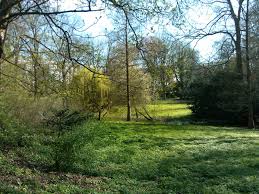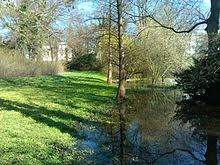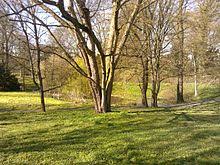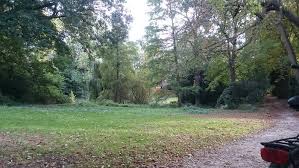The Eschenburg Park is located in St. Mark's Square. Gertrud near Travemünder Allee. It is bordered by East Jerusalem to the east by Constestras and from the west by Gertrudenstrasse. To the south, the garden is bordered by Dorothea Schlözer.
Date
The meadows in front of the castle gate, which formed a slope gently tilted to the edge, were famous sites of summer houses and gardens associated with wealthy Lupic citizens since the seventeenth century because of their wonderful location.
The essence of Eschenburgpark later formed the garden of Kuhlmannsche Garten, a long, narrow piece built by architect Christian Frederick Hansen in 1804 for the cousin of the Hamburg Baur Villa Kuhlmann (the current Eschenburg Villa) on the east side. Only the garden's time of origin can be determined; the 1806 map shows three clearly defined smaller plots. The oldest visible representation of the park is a plan for the area in front of the castle gate, which was made by Karl Haas in 1823. The Coleman Park appears dense, with shrubs cut by paths up to the vicinity of the house; only in the eastern part there are tree-shaped trees. It is assumed that the trees, shrubs and wrinkles of the previous individual plots were preserved in order to achieve a pleasant natural effect, in keeping with contemporary English landscape gardens.
The owner was named since about 1795, a merchant and consul Johan Coleman (1753-1804), who married his daughter from a municipal councilor and later mayor Bernhard Heinrich Fraser, and so the park was owned in 1822. His seed sold the land and the villa in 1876 to the businessman Henry Koch, who expanded the park to the north. Most large trees still exist from this period.
In 1885, the park moved to Johann Hermann Eichenburg, which greatly increased it by buying it the following year. In the southwest, a pool was built, and in 1891, the entire estate was surrounded by a wrought-iron fencing. There are few details about the specific design of the park at the time, so you can not tell the arrangement and cultivation of flower bottoms or the nature of the trees. However, a preference can be seen for the yew, and the exotic ginkgo trees have now been planted. After Gertrudenstraße there was a kitchen garden offering to grow fruit and vegetables as well as a greenhouse.
In 1939, after the death of the widow of Ischenberg, the house and property were changed to the German Reich as a new owner. The villa was used during World War II as the headquarters of Lubeck police chief Walter Schroeder, and the park was grossly neglected. In the post-war years, the population rented parts of the area for vegetable growing and animal husbandry, while in Villa Eschenburg since October 1950, the Schleswig-Holstein Academy of Music and the North German School of Members.
In 1955, the city decided on the initiative of the city park manager Ernest Hagaiman in coordination with the Music Academy to make the park public. The agreement was based on a long-term care contract that regulates the rights and obligations of the city and the academy in the design, maintenance and use of the facility, which is still in effect today. In 1957 the park was given under the name New Volksgarten to the public. Organizationally, it belonged to the school garden, and was designed accordingly: the park was designed as a wooded garden and planted in particular with rhododendrons which were rare in Europe, including some valuable species. Because of the precious plants sometimes, the park was closed for many years every day when it was dark.
In the transition to the curriculum, significant changes were made to the entire system, which lost the original character of the private garden, although the preservation was an explicit part of the maintenance contract. Another major intervention took place in 1970, when the Dorothea Schlosser vocational school was built on the site adjacent to the southern side of the former Buchenhof and part of the park was relinquished for this purpose.
In 1986, the gardening office was instructed by the citizen not to take an active interest for environmental reasons from the Eisenberg Park and instead, among other things, to remove paved roads in the 1950s to remove part of the roads and carry out repair measures. , Lost parts of valuable timber plantations and the spatial effect of the park can no longer be detected by increasing wild growth. In the canceled tracks, the extravagant tracks that were returned to the original factory in the early 19th century, while maintaining guided tours since the 1950s, are no longer logical as they are no longer directed to the current show farms. The pond is no longer increasingly preserved.
Because of its less attractive appearance, the park is currently visiting little.





